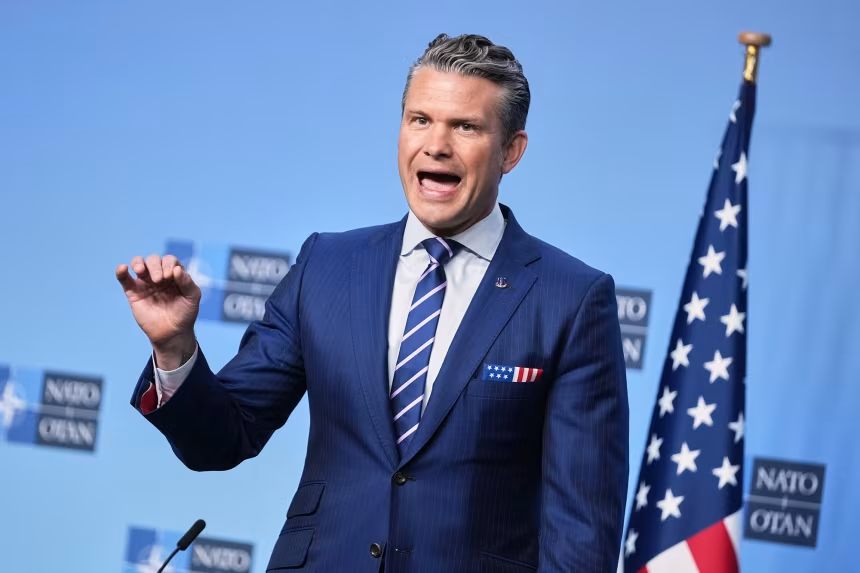NATO’s Firepower Gamble: Allies Promise “Shock and Awe” for Ukraine as Tomahawk Tensions Boil Over
A storm is brewing inside NATO’s marble halls. As U.S. Defense Secretary Pete Hegseth landed in Brussels this week, he declared that “firepower is coming for Ukraine.” But behind the polished promises and diplomatic smiles, one explosive question is rattling the corridors of power: Will the U.S. finally unleash Tomahawk missiles for Kyiv?
In a meeting thick with symbolism and tension, Hegseth vowed that Europe’s new commitments would soon “turn into capabilities” for Ukraine, signaling a military turning point in the war. Yet the Tomahawk missile deal, a move that could change the conflict’s entire geography, remains off the official NATO agenda — locked away in the hands of one man: President Donald Trump.
The Stakes: Tomahawks Could Change Everything
Under the new Prioritized Ukraine Requirements List (PURL) — a funding mechanism allowing NATO allies to pool resources — more than $2 billion has already been committed to Kyiv’s defense. But Ukrainian President Volodymyr Zelensky wants something more decisive: the ability to strike deep into Russian territory.
What are Tomahawk missiles, and why does Ukraine want them?
Tomahawks are U.S.-made long-range cruise missiles capable of hitting targets up to 1,500 kilometers away. Designed for precision strikes, they could allow Ukraine to neutralize Russian command centers, supply depots, and missile sites far beyond the front line — potentially putting Moscow itself within range.
That’s exactly why the decision is so sensitive. Trump, whose relationship with Vladimir Putin remains one of Washington’s enduring mysteries, has been coy about approving the sale. He is expected to face intense pressure from Zelensky during their Friday meeting at the White House.
The Shadow Strategy: NATO’s Secret Race for Long-Range Deterrence
Beyond the public speeches, NATO officials are quietly admitting what few will say aloud — Europe is preparing for a long war with Russia, one that could outlast Ukraine’s current fight.
A classified briefing reviewed by several defense ministers reportedly warns that Russia is modernizing faster than expected, expanding its missile production lines and electronic warfare capabilities across western Russia and Belarus.
Finland’s Defense Minister Antti Hakkanen summarized it bluntly:
“Russia is rebuilding for the second phase of aggression. Even after Ukraine, there are real threats for Europe.”
NATO insiders call this strategy “deep deterrence” — the creation of overlapping defense systems designed not just to protect Ukraine, but to push Russian forces back from Europe’s borders.
Drones, Missiles, and the Future of Air Warfare
While Tomahawks remain stalled in Washington, other promises are already taking flight.
-
Britain has pledged 100,000 drones to Ukraine — the largest drone commitment by any NATO nation to date.
-
The Netherlands has committed €90 million ($104 million) to help Ukraine build its own drone-manufacturing capacity.
These efforts come after a series of Russian drone incursions into Polish airspace, prompting NATO fighters to engage and destroy several unidentified aircraft — the first combat engagement over NATO territory since the invasion began.
“If NATO is threatened, we will act,” warned British Defense Minister John Healey, calling Russia’s behavior “reckless and totally unacceptable.”
Dutch Defense Minister Ruben Brekelmans, whose F-35s helped neutralize several drones, acknowledged the growing challenge:
“F-35s are powerful, but they’re not the most efficient way to take out drones. We need smarter, faster, cheaper tools for this new kind of warfare.”
The Escalation Dilemma
Every new weapon Kyiv receives edges the world closer to a tipping point. Latvia’s Defense Minister Andris Sprūds framed it as a moral necessity:
“If Russia bombs civilian infrastructure, Ukraine has every right to hit military targets inside Russia. This is self-defense.”
But Western analysts warn that the introduction of long-range strike capability could provoke a fierce Russian reaction — potentially widening the war.
That’s the balancing act confronting Trump and NATO leaders: arm Ukraine enough to win, but not enough to ignite World War III.
What Happens If Ukraine Gets Tomahawks?
If Ukraine were to acquire Tomahawk missiles, it would fundamentally alter the war’s dynamics.
In plain English: it would give Ukraine the ability to strike anywhere in Russia, with precision, from hundreds of miles away.
This shift would turn Ukrainian defense into strategic deterrence, forcing Russia to spread its defenses thin and potentially halting large-scale bombardments on Ukrainian cities.
However, it could also trigger new Russian retaliation, cyberattacks, or even nuclear posturing — risks that NATO is struggling to calculate.
The Bottom Line
For now, Ukraine is getting drones, ammunition, and “firepower,” but not the Tomahawks that could change the map. As Trump and Zelensky prepare for their high-stakes meeting, Europe is watching closely — aware that one signature could redefine the continent’s security for a generation.
The question haunting Brussels isn’t if Ukraine will get Tomahawks — it’s when, and at what cost.
The Arsenal Already Supplied: How Much Firepower the U.S. Has Sent
While NATO debates the next wave of weapons, Washington has already poured tens of billions of dollars into Ukraine’s defense.
According to the U.S. State Department’s Bureau of Political-Military Affairs, the United States has supplied more than $66.9 billion in military assistance since February 2022 — and nearly $70 billion since the first Russian incursion in 2014.
That aid covers an arsenal unmatched in modern history:
-
Air Defense: Patriot batteries, NASAMS launchers, Stinger missiles, and nearly two dozen air-surveillance radars now guard Ukrainian skies.
-
Heavy Artillery: Over 40 HIMARS rocket systems, 200 howitzers, and more than 3 million 155 mm shells have been delivered, giving Ukraine one of the densest artillery networks in Europe.
-
Armor and Vehicles: 31 Abrams tanks, 300 Bradley fighting vehicles, 900 M113 personnel carriers, 1,000 MRAPs, and fleets of Strykers and HMMWVs.
-
Drones and Aircraft: Mi-17 helicopters and an expanding lineup of Switchblade, Phoenix Ghost, and Puma UAS, plus Western-compatible radar and F-16 support gear.
-
Anti-Armor Weapons: More than 10,000 Javelins, 120,000 other anti-tank systems, and half a billion rounds of small-arms ammunition.
-
Maritime and Support Gear: Harpoon coastal missiles, patrol craft, satellite comms, electronic-warfare equipment, and 100,000 sets of body armor.
Much of this matériel was drawn directly from Department of Defense stockpiles under the Presidential Drawdown Authority (PDA) — invoked 55 times since 2021, worth about $31.7 billion. Additional billions have flowed through Foreign Military Financing (FMF) and the Ukraine Security Assistance Initiative (USAI), funding longer-term projects such as drone production, training, and air-defense integration.
In total, the United States and nearly 50 partner nations have contributed:
359 tanks, 629 armored vehicles, 178 artillery systems, 88 lethal UAVs, and more than 250,000 anti-tank munitions.
For Kyiv, these numbers are more than accounting—they represent survival. And for NATO, they underscore the alliance’s pivot from symbolic solidarity to sustained, industrial-scale warfare support.
Source: Bureau of Political-Military Affairs, Office of Congressional and Public Affairs, U.S. Department of State (March 12, 2025).
People Also Ask (SEO & Snippet Section)
Will Ukraine receive Tomahawk missiles from the U.S.?
Not yet. The decision is pending approval from President Donald Trump, who may revisit the issue during his upcoming meeting with President Zelensky. If authorized, it would mark the first time the U.S. has exported Tomahawk missiles for active combat outside NATO.
What is NATO’s PURL initiative?
The Prioritized Ukraine Requirements List (PURL) is a NATO mechanism allowing allies to fund and coordinate large-scale weapons purchases for Ukraine’s defense, focusing on air defense systems, drones, and long-range artillery.
What is “deep deterrence”?
“Deep deterrence” is NATO’s emerging defense strategy that focuses on long-range missile systems, drones, and integrated air defenses to prevent Russian incursions before they reach European airspace.













